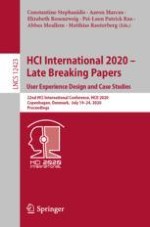2020 | OriginalPaper | Chapter
The Effect of Device-Affordance Alignment with the User Goal on User Experience
Authors : Audrey Bond, Pierre-Majorique Léger, Sylvain Sénécal
Published in: HCI International 2020 - Late Breaking Papers: User Experience Design and Case Studies
Publisher: Springer International Publishing
Activate our intelligent search to find suitable subject content or patents.
Select sections of text to find matching patents with Artificial Intelligence. powered by
Select sections of text to find additional relevant content using AI-assisted search. powered by
